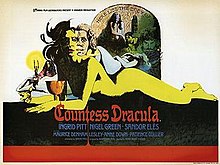|
Countess Dracula
Countess Dracula is a 1971 British Hammer horror film directed by Peter Sasdy and starring Ingrid Pitt, Nigel Green and Lesley-Anne Down.[1] It was produced by Alexander Paal. Countess Dracula was inspired by the infamous Hungarian Countess Elizabeth Báthory (1560–1614), a landowner and noblewoman who was accused of murdering dozens of women and girls.[2] Her husband was Ferenc Nádasdy, Nádasdy being the surname given to the Countess in the film. PlotIn 17th-century Hungary, recently widowed Countess Elisabeth Nádasdy discovers that her youthful appearance and libido can be temporarily restored if she bathes in the blood of young women. She enlists her steward and lover Captain Dobi and her maid Julie to help with the kidnap and murder of several local girls, whilst beginning a romance with a young Lieutenant named Imre Toth. As a cover for her crimes while in her rejuvenated state, she takes the identity of her own 17-year-old daughter, Countess Ilona, whom she has Dobi hold captive in the woods by the mute money gambler. However, castle historian Fabio grows suspicious. Eventually, she kills a prostitute called Ziza, but her blood does not restore her like the others. Dobi finds Fabio, who has a book-chapter about blood sacrifices and tells Elisabeth the truth in return for being allowed to live. He reveals that only virgin blood will restore Elisabeth's youth and beauty. Elisabeth then kills a peasant girl bought in the marketplace. Fabio tries to tell Toth the truth about her, but Dobi kills Fabio before he can do so. Dobi then exposes Elisabeth to Toth to steer him away from her. Elisabeth forces Toth into marrying her, but her daughter Ilona arrives home, having been brought by Dobi as a sacrifice, then freed by a repentant Julie who loved her as a daughter. At the wedding, Elisabeth grows old again after the priest pronounces the blessing. She tries to kill her daughter in front of the wedding attendees, but accidentally kills Toth instead. Elisabeth, Dobi and Julie are sentenced to death for their crimes and are last seen awaiting the hangman in their cell. In the final scene, the peasants curse Elisabeth as a "devil woman" and "Countess Dracula". Cast
ProductionThe original music score was composed by Harry Robertson. ReleaseThe film opened at the New Victoria cinema in London on 31 January 1971 before going on general release in the UK on 14 February.[3][4] It opened October 1972 in the United States.[5] It was released[where?] on a double bill with Vampire Circus (1972). Critical receptionAllmovie has retrospectively called the film "one of the more underrated films from the latter days of the Hammer Films dynasty."[6] The Hammer Story: The Authorised History of Hammer Films, on the other hand, wrote that the film's "distinctly anemic blood-lettings fail to lift a rather tiresome tale of court intrigue."[7] New York Times film critic Howard Thompson considered it "better than most [horror movies] in a sea of trashy competition", and called Peter Sasdy's direction "smooth and pointed" with "crisp, cutting edge" dialogue, until the last act of the film where "it runs out of gas, along with the desperate old woman [Countess Elizabeth]."[8] David Pirie of The Monthly Film Bulletin called the acting "extremely poor," but found that the film "frequently takes on a nightmare quality" and that Pitt "brings to the part a very potent aura of physical corruption that is especially effective in the transformation sequences."[9] Home mediaThe film is available on DVD from Metro-Goldwyn-Mayer in the US as a double-bill with The Vampire Lovers, and from Carlton in the UK in a box set with Twins of Evil and Vampire Circus. Synapse released a Blu-ray/DVD combo pack in the U.S. in 2014, which featured a new high-definition transfer. See also
References
External links
|
||||||||||||||||||||||||||||||
